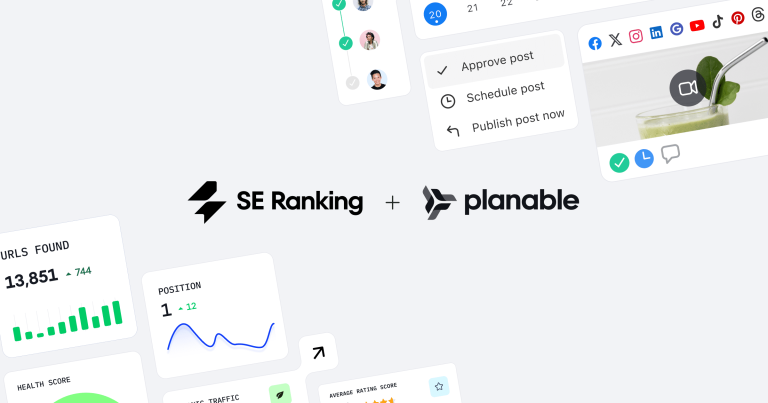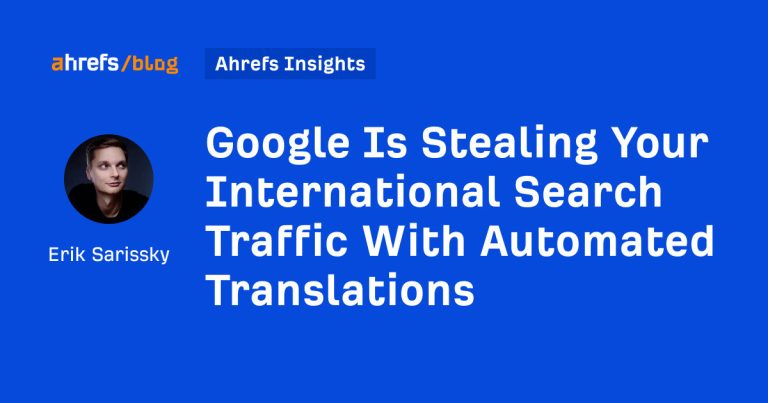How AI-Generated Content Performs: Experiment Results
Businesses have been using AI to automate different tasks, including content creation, for a while. But how effective is it exactly?
From an ethical standpoint, Google says that content should be high-quality and genuinely benefit users, no matter how it’s created. However, using AI to manipulate rankings goes against Google’s spam policies.
We conducted two experiments to see how AI-generated articles perform in different environments. First, we published six AI-assisted articles on the SE Ranking blog to see how they’d perform on our domain. We then took a step further by launching 20 brand-new websites and publishing 2,000 AI-generated articles throughout. Our goal was to discover if AI-written content could gain traction and bring in measurable traffic.
Let’s look at the results of our experiments!
Key Experiment Results
SE Ranking blog results:
- Six AI-assisted articles received almost 138K impressions and 866 clicks during the experiment’s six-month duration.
- Three of six AI articles on the SE Ranking blog currently rank in the organic top 10.
- 3 AI-assisted articles on the SE Ranking blog trigger AI Overviews and 2 of them are featured as sources.
New domains results:
- 70.95% of new pages with AI-generated content were indexed during the first 36 days.
- Google fully indexed 11 out of 20 new websites that feature AI-generated content.
- Eight sites with AI-written articles started to rank for over 1,000 keywords, each within one month.
- Pages with generated content received 122K impressions and 240+ clicks.
- 5 websites with AI articles have up to 30% of their keywords in the top 30 on desktop and up to 37% on mobile.
- 932 out of the 2,000 examined keywords (46.60%) resulted in AI Overviews in search.
- On average, 47 out of every 100 keywords per niche triggered AI Overviews.
Disclaimer:
We conducted this experiment to get insights into how AI-generated content performs in real-world conditions. Our findings and observations are for informational and educational purposes only. We strongly discourage using the data from this experiment to manipulate search algorithms and rankings.
Remember that while AI can help with generating content, we don’t recommend relying on it as the sole method for content creation. Always review, edit, and customize AI-generated content thoroughly and add human expertise. Always ensure that AI-created copies align with your brand voice, meet quality standards, and accurately serve your audience’s needs.
Testing AI-generated articles on the SE Ranking blog
We started our experiment by testing how AI-generated articles would perform on the SE Ranking blog. The goal was to evaluate whether AI-written materials could rank well on SERPs and attract traffic. We used the AI Writer to generate texts, published them on our blog, and tracked performance with Google Search Console, Keyword Rank Tracker, and AI Results Tracker.
In the following sections, you’ll find more details about how we set up our experiment and the results we achieved on our blog.
SE Ranking blog experiment methodology
Selecting topics and generating content
We identified six topics that we believed would resonate well with our readers:
- Seed keywords
- Dashboards vs reports
- Product-led growth
- SEO benchmarking
- Taxonomy SEO
- Local business reviews
These target keywords served as the foundation for individual articles. We added them to SE Ranking’s Content Editor and used our AI Writer to create texts. This feature supports several generation formats:
- One-click article generation: This approach involves adding a target keyword and generating text immediately, without custom settings.
- Article generation via Wizard: Specify initial requirements for the AI Writer to follow when generating texts.
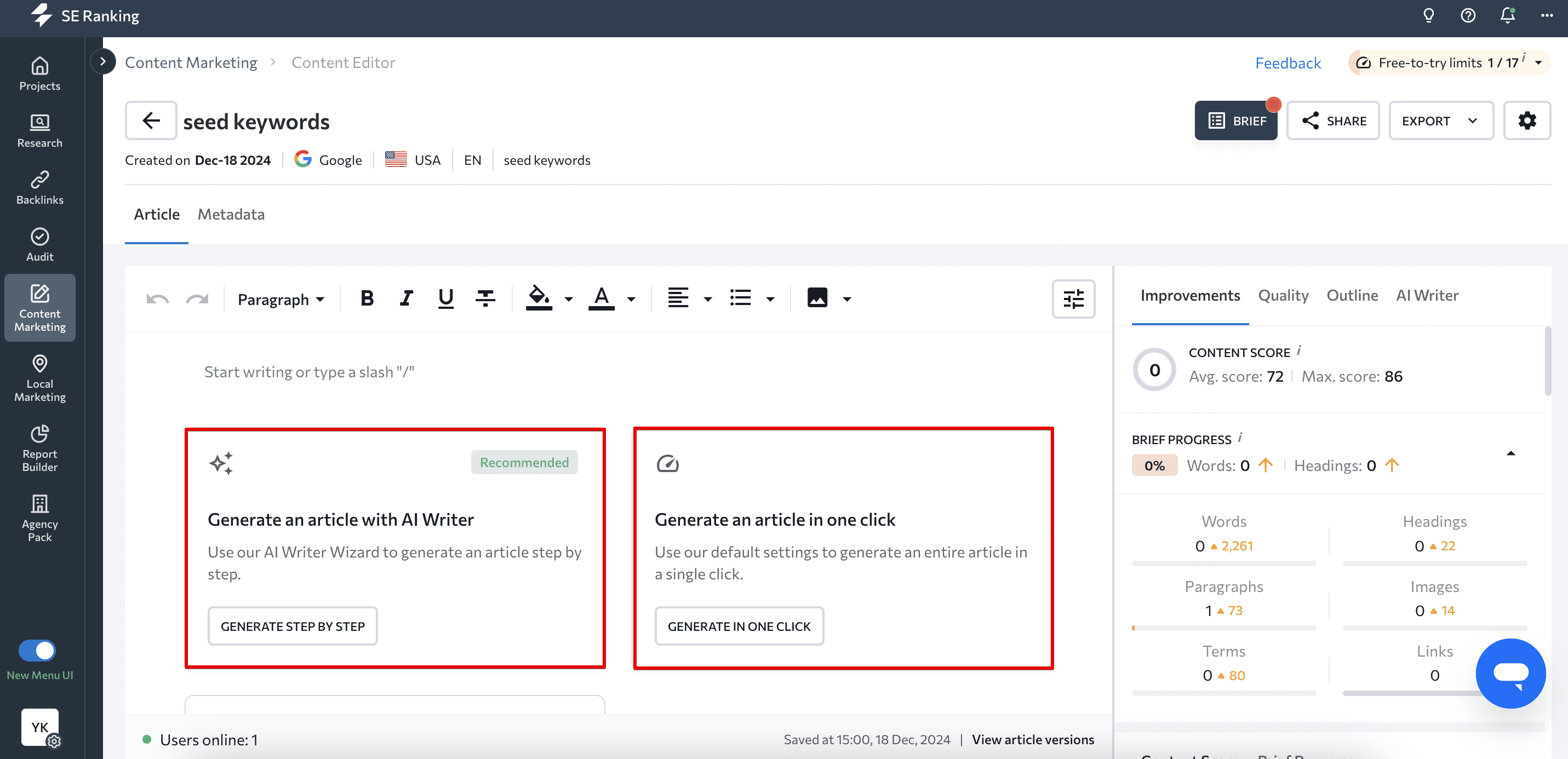

We chose the second option to cover the selected topics comprehensively and ensure articles are on par with our blog’s standards. Before generating articles, we examined each topic to establish a solid outline and specified the following requirements to the AI Writer:
- User intent
- Target audience
- Content format
- Tone of voice
- Creativity level
We guided the AI step-by-step through the Wizard and provided the following context:
- Critical points to be covered
- Relevant keywords to incorporate
- Specific questions to be answered
- H1 heading
- Heading structure
Based on this information, the AI Writer produced our article first drafts.
Editing AI-generated drafts
AI-generated drafts served as a starting point rather than as a final product. Our team revised each article for clarity and accuracy. Our SEO team also reviewed selected pieces for factual correctness.
We used our Content Editor’s recommendations to make small revisions to the text and improve the Content Score.
We didn’t proofread these articles.
To maintain transparency, we included the following disclaimer in each published piece:
“This article was initially drafted using SE Ranking’s AI Writer. However, some parts of the text were written from scratch and the content has undergone thorough revisions, editing, and fact-checking by human editors and subject matter experts to ensure accuracy.”
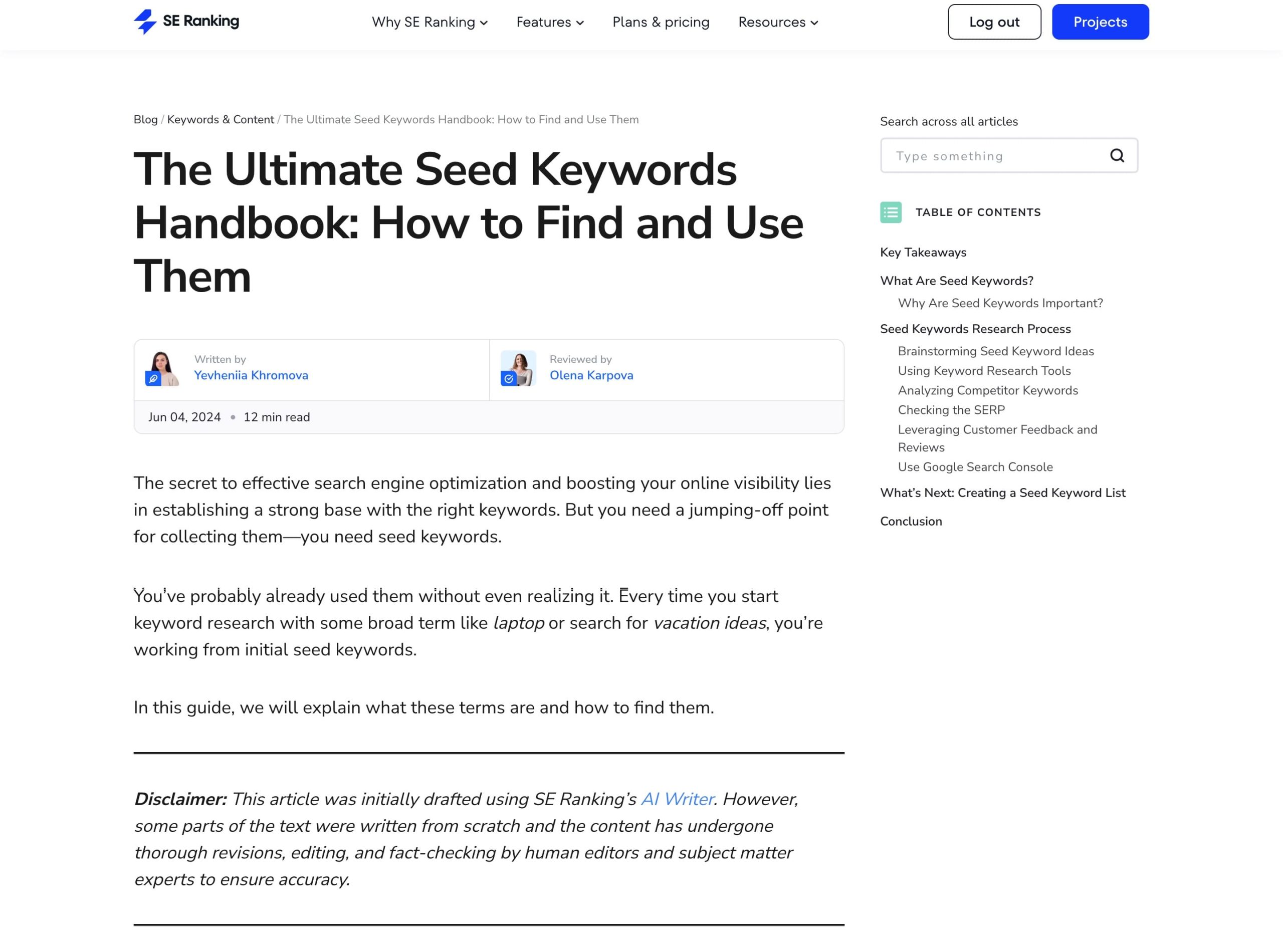

Publishing polished articles on the SE Ranking blog
Once all adjustments were made, we published AI-assisted articles on our blog on the following dates:
SE Ranking blog experiment results
AI-generated articles got 137K impressions and 860+ clicks in 6 months
We tracked each article’s clicks and impressions in Google Search Console, starting from the publication date. We also monitored their performance in 30-day intervals as each article was published on a separate date. In total, all AI-generated articles accumulated a combined 137,815 impressions and 866 clicks over a six-month period.
Below you’ll find GSC data showing the impressions and clicks, broken down into 30-day periods:
https://seranking.com/blog/seed-keywords/
- 4,527 impressions
- 14 clicks
- 5,325 impressions
- 19 clicks
- 6,983 impressions
- 31 clicks
- 6,313 impressions
- 28 clicks
- 8,890 impressions
- 49 clicks
https://seranking.com/blog/dashboards-vs-reports/
- 2,889 impressions
- 21 clicks
- 5,442 impressions
- 53 clicks
- 8,195 impressions
- 74 clicks
- 11,529 impressions
- 128 clicks
- 14,765 impressions
- 184 clicks
- 14,758 impressions
- 174 clicks
https://seranking.com/blog/product-led-growth/
https://seranking.com/blog/seo-benchmarking/
- 3,649 impressions
- 7 clicks
- 5,486 impressions
- 12 clicks
- 6,682 impressions
- 16 clicks
https://seranking.com/blog/seo-taxonomy/
- 1,805 impressions
- 4 clicks
- 2,440 impressions
- 4 clicks
- 3,096 impressions
- 28 clicks
https://seranking.com/blog/local-business-reviews/
- 4,659 impressions
- 2 clicks
- 6,598 impressions
- 8 clicks
- 4,983 impressions
- 7 clicks
https://seranking.com/blog/seed-keywords/
- 4,527 impressions
- 14 clicks
- 5,325 impressions
- 19 clicks
- 6,983 impressions
- 31 clicks
- 6,313 impressions
- 28 clicks
- 8,890 impressions
- 49 clicks
https://seranking.com/blog/dashboards-vs-reports/
- 2,889 impressions
- 21 clicks
- 5,442 impressions
- 53 clicks
- 8,195 impressions
- 74 clicks
- 11,529 impressions
- 128 clicks
- 14,765 impressions
- 184 clicks
- 14,758 impressions
- 174 clicks
https://seranking.com/blog/product-led-growth/
https://seranking.com/blog/seo-benchmarking/
- 3,649 impressions
- 7 clicks
- 5,486 impressions
- 12 clicks
- 6,682 impressions
- 16 clicks
https://seranking.com/blog/seo-taxonomy/
- 1,805 impressions
- 4 clicks
- 2,440 impressions
- 4 clicks
- 3,096 impressions
- 28 clicks
https://seranking.com/blog/local-business-reviews/
- 4,659 impressions
- 2 clicks
- 6,598 impressions
- 8 clicks
- 4,983 impressions
- 7 clicks
Articles published earlier (e.g., Dashboards vs Reports and Seed Keywords) received more clicks and impressions because they had more time to rank and gain traction. For example, Seed Keywords started around 4,500 impressions in the first 30 days and nearly doubled that by the 6th period. The Dashboards vs Reports article showed even more dramatic growth, jumping from roughly 2,900 impressions in the first 30 days to over 11,000 impressions by the 4th interval and 14,000+ in the 5th and 6th.
The clicks for each article fluctuated for various reasons. For instance, Seed Keywords saw a drop from 28 clicks in the fourth interval to 20 in the fifth, but then rebounded to 49 in the sixth. The Dashboards vs Reports piece showed a more consistently upward trend in clicks.
Articles released in August and September (Product-Led Growth, SEO Benchmarking, SEO Taxonomy, Local Business Reviews) had less total time to accumulate impressions and clicks, but they can still catch up. Some of the articles published later on achieved several thousand impressions in their first 30 days, which is a strong early signal for newly published content.
3 of the generated articles rank in the organic top 10
We also tracked AI-generated articles and keywords with our Rank Tracker to see how positions changed over time. We chose December 12, 2024, as the end date for tracking the positions for each article in our experiment (but we have been tracking positions throughout and continue to do so now).
As you can see from the table below, three articles are currently ranking in the top 10, one post is in position 12, and two pieces show no performance.
https://seranking.com/blog/seed-keywords/
Position 27 on June 21, 2024
Position 10 on August 4, 2024
Position 6 on October 23, 2024
Position as of December 12
https://seranking.com/blog/dashboards-vs-reports/
Position 28 on July 22, 2024
Position 10 on August 2, 2024
Position 1 on September 12, 2024
Position as of December 12
https://seranking.com/blog/product-led-growth/
Position as of December 12
https://seranking.com/blog/seo-benchmarking/
Position 23 on September 25, 2024
Position 8 on October 7, 2024
Position 7 on October 30, 2024
Position as of December 12
https://seranking.com/blog/seo-taxonomy/
Position 32 on September 9, 2024
Position 10 on September 23, 2024
Position 7 on November 21, 2024
Position as of December 12
https://seranking.com/blog/local-business-reviews/
Position 78 on September 19, 2024
Position 10 on October 6, 2024
Position 10 on October 6, 2024
Position as of December 12
https://seranking.com/blog/seed-keywords/
Position 27 on June 21, 2024
Position 10 on August 4, 2024
Position 6 on October 23, 2024
https://seranking.com/blog/dashboards-vs-reports/
Position 28 on July 22, 2024
Position 10 on August 2, 2024
Position 1 on September 12, 2024
https://seranking.com/blog/product-led-growth/
https://seranking.com/blog/seo-benchmarking/
Position 23 on September 25, 2024
Position 8 on October 7, 2024
Position 7 on October 30, 2024
https://seranking.com/blog/seo-taxonomy/
Position 32 on September 9, 2024
Position 10 on September 23, 2024
Position 7 on November 21, 2024
https://seranking.com/blog/local-business-reviews/
Position 78 on September 19, 2024
Position 10 on October 6, 2024
Position 10 on October 6, 2024
The screenshots from our Rank Tracker (shown below) present position dynamics for each article, beginning at the publication date and ending on December 12, 2024.
2 generated articles made it to the sources section in AI Overviews
We added our target keywords to SE Ranking’s AI Results Tracker to see if they trigger AI Overviews in search. We also checked if our generated articles were cited as sources in these AI responses.
Two out of six keywords triggered AI Overviews and respective articles were linked as sources in AIOs. Included were the Dashboards vs Reports and Taxonomy SEO articles. The local business reviews keyword triggered AI Overviews, but our related article didn’t make it to the source list. The rest of the keywords currently don’t trigger AIOs.
The results of the initial experiment on our blog are encouraging. The AI-generated articles not only secured search visibility but also began to attract traffic. Half of them rank in the organic top 10 and two appear as sources in AI Overviews. However, these positive outcomes might have been influenced by our domain’s already established authority and trust. To see if similar results could be achieved under less favorable conditions, we broadened our study, leading to the second part of our experiment.
Testing AI-generated content on 20 brand-new websites
With this second iteration, we wanted to see how AI-generated content would perform when published on brand-new domains with no existing reputation. We also looked for any dependencies on the domain’s niche. Our goal was to see how AI content gets indexed, how well it can rank in search results, and whether it has traffic potential.
We accomplished this by testing 2,000 AI-generated articles across 20 newly registered domains. The following sections provide more details on our methodology and results.
New domains experiment methodology
Selecting niches and keywords
We chose 20 popular and broad-ranging niches to cover diverse interests and industries. These included:
- Arts & Entertainment
- Business & Services
- Community & Society
- Computers & Technology
- Ecommerce & Shopping
- Finance & Accounting
- Food & Drink
- Games & Accessories
- Health & Medicine
- Industry & Engineering
- Hobbies & Interests
- Home & Garden
- Jobs & Career
- Law & Government
- Lifestyle & Well-being
- Pets & Animals
- Science & Education
- Sports & Fitness
- Travel & Tourism
- Vehicles & Boats
For each niche, we selected 3–5 top-performing, authoritative websites that ranked for relevant how-to keywords. We used our Competitive Research Tool to extract informational how-to queries and applied filters to get a list of low-search-volume keywords.
In cases where niches didn’t have enough low-search-volume terms, we supplemented the list with medium-search-volume queries. The monthly search volumes for the selected keywords ranged from 10 to 990, with an average of 106 across all niches.
We reviewed the keywords to match our criteria and cover different topics within each niche. This resulted in our keyword list of 100 how-to queries per niche and 2,000 keywords in total. Find the complete keyword list in this document.
Buying new domains and setting them up
To create a standardized environment, we purchased 20 brand-new domains—one for each niche. These domains had no prior search history, backlinks, or established reputations.
We made WordPress the content management system for each website. To maintain consistency across all sites, we applied the same free WordPress theme and activated only one additional plugin: Yoast SEO.
We didn’t make further customizations or enhancements. No internal linking was employed, and no images were added.
Generating content and publishing it on new websites
We generated content in one click using SE Ranking’s AI Writer. We created 2,000 articles in total and 100 per niche. We didn’t provide extra prompts, guidance, or edits. We also generated titles and meta descriptions for each content piece.
The generated content was used as-is. We generated articles in bulk with the help of our development team.
We then exported these AI-generated articles and uploaded them to the corresponding WordPress sites via SE Ranking’s WordPress API.
Each site received 100 articles during the same period on November 5-6, 2024. We added no further manual adjustments, internal linking, or images.
Tracking approach
After the content went live, we added each site to Google Search Console to monitor its indexing and performance metrics. We submitted sitemaps to encourage indexing without any other indexing or promotional tactics. We conducted no link-building campaigns, created no internal link structures, and promoted nothing on social media. These sites were left untouched because we wanted them to be evaluated based on merit alone.
We also added our keyword list to:
All data was tracked in the US.
We gave the sites 36 days before checking the results.
Results of the new domains experiment
70.95% of all generated pages were indexed in the first 36 days
Between November 6 and December 11, 2024, we monitored Google as it indexed the 2,000 AI-generated articles published across 20 new domains. The indexing rate reached 70.95% (1,419 out of 2,000 pages), meaning that almost two-thirds of all published pages were successfully included in Google’s search results within a little over one month.
This is a high rate given that different estimates suggest that only about 15% to 20% of the entire web gets indexed. John Mueller from Google also noted that it’s normal for not all 100% of your pages to be indexed.
- 11 sites saw full indexation, with all 100 pages per site included in Google’s index.
- 3 sites achieved substantial, though not complete, indexation of 78–97 pages.
- 2 sites lagged behind, each having only 18 indexed pages.
- 4 niches struggled to get indexed by Google, each with fewer than 10 pages indexed.
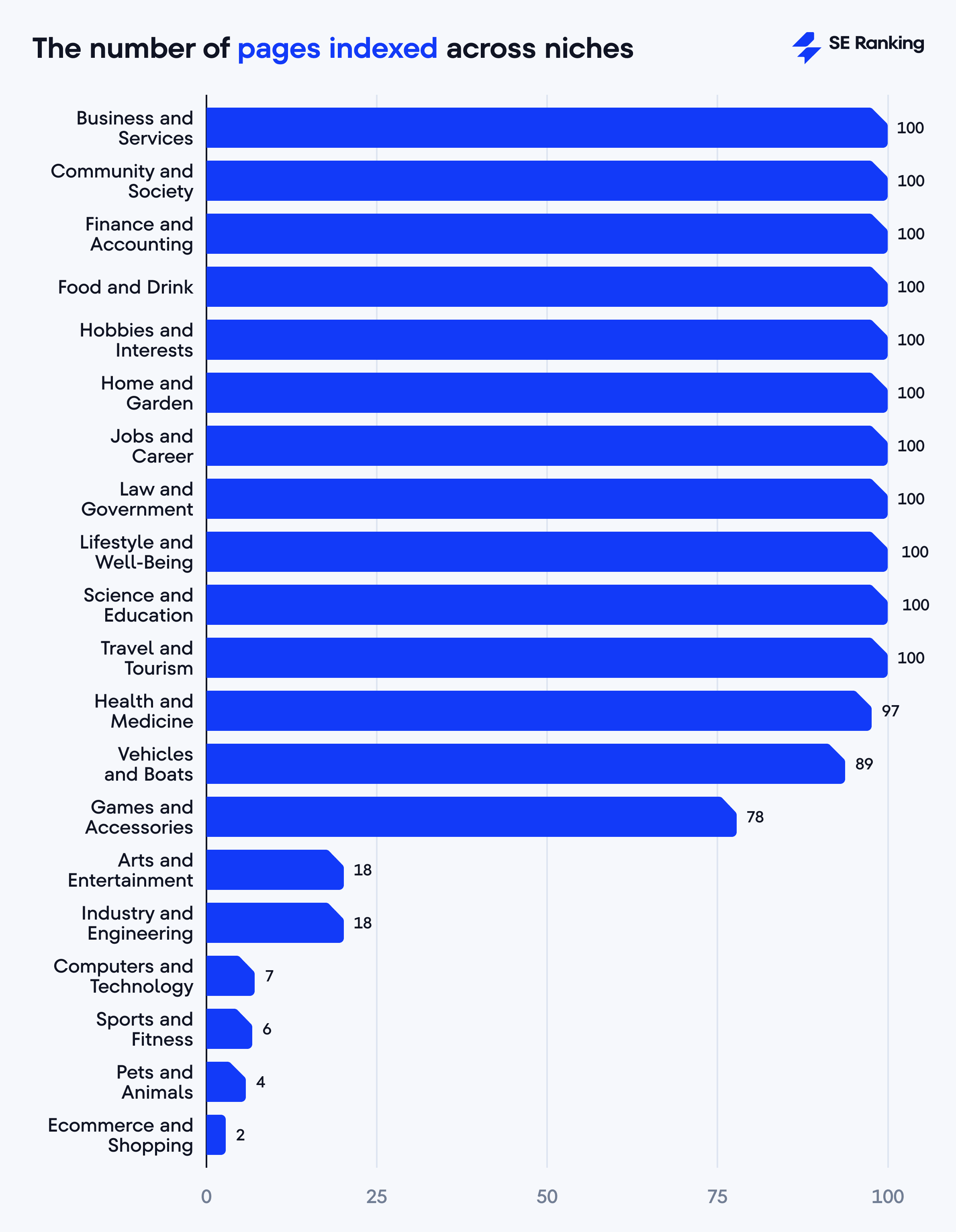

Google fully indexed over half of the tested websites in roughly one month. This suggests that the search engine is open to crawling and indexing brand-new domains and can do so even if the content is entirely AI-generated.
Many niches with a 100% indexation rate (Food & Drink, Home & Garden, Jobs & Career, Lifestyle & Well-being, etc.) are evergreen and broad topics. In contrast, more competitive or specialized areas like Ecommerce & Shopping and Computers & Technology displayed slower indexing, possibly due to stricter content evaluation.
Some niches that can be attributed to the Your Money Your Life category (Health & Medicine and Finance & Accounting) achieved full or near-complete indexation. These results suggest that even AI-generated material—if well-structured and relevant—can meet Google’s basic indexing criteria.
8 websites started to rank for 1000+ keywords in 36 days
We also analyzed how many keywords each site began ranking for within the first month. Instead of the hand-picked “how-to” keywords we targeted during content creation, these keywords represent all terms for which GSC detected organic visibility.
Our 36-day results show that:
- Eight sites had an impressive start, ranking for over 1,000 different keywords each.
- Eight sites landed in the mid-range category, visible for between 100 and 1,000 keywords.
- Three sites had more modest visibility, ranking for between 30 and 100 keywords.
- One site barely gained traction, with only 2 detected keywords.
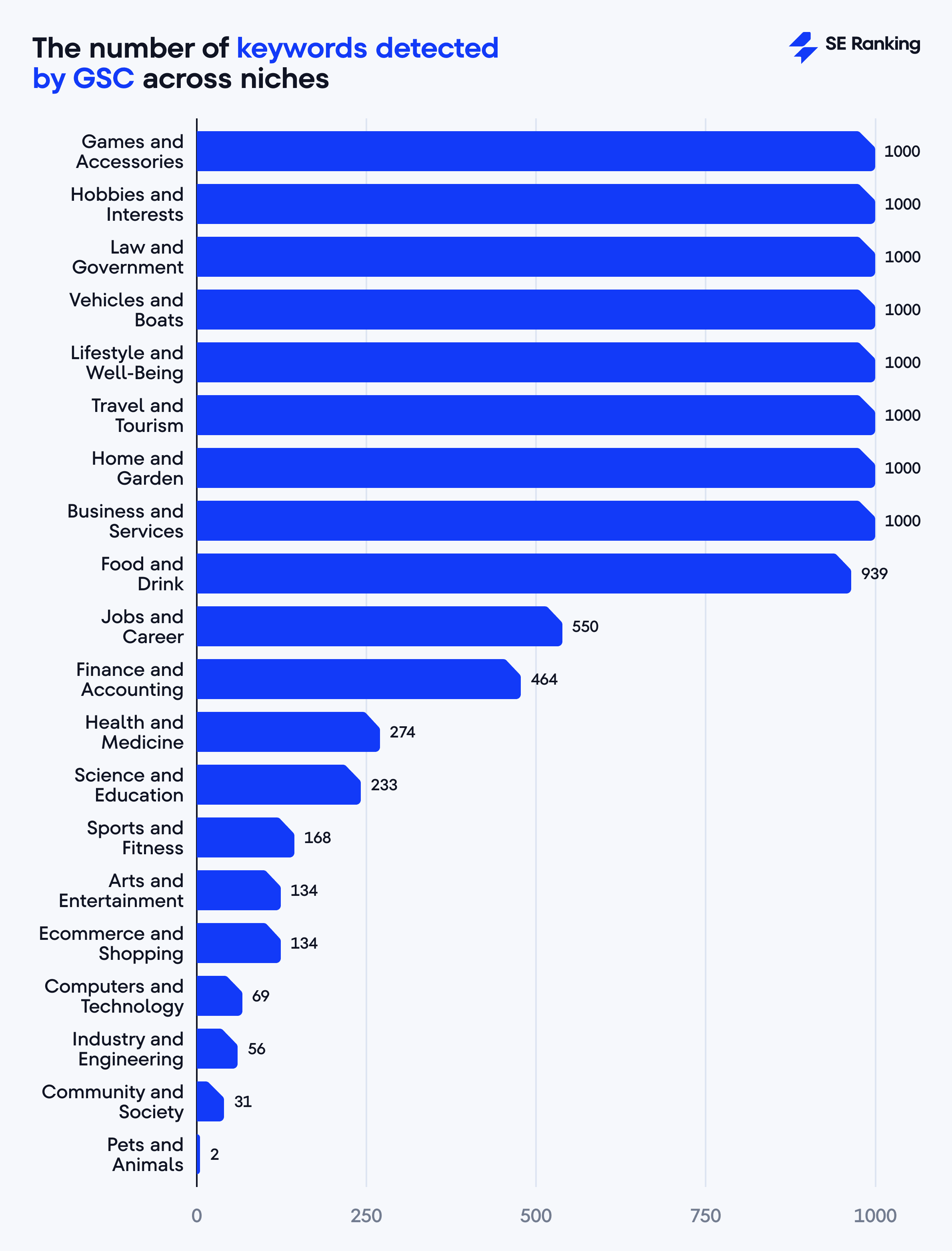

As for the positions these domains achieved across all keywords identified by GSC:
- Five sites have all their GSC keywords ranking between positions 29.7—49.3 on average.
- Fourteen sites have all their GSC keywords ranking within positions 52.3–73 on average.
- One site has all its GSC keywords ranking in position 112.8 on average.
Some niches like Business & Services, Games & Accessories, Hobbies & Interests, etc., lend themselves to broader keyword coverage. The variations in keyword quantity and average ranking position for them highlight that, while AI-generated content can secure a foothold in search results, improved rankings will likely depend on further optimization, content enhancements, and establishing domain authority. These initial results, however, indicate that simply posting AI-generated “how-to” articles can yield measurable visibility.
Generated content accumulated 240+ clicks and 122K impressions
We examined that early traffic and impression data and metrics across all domains are quite noticeable:
- 244 clicks in total
- 122,102 impressions in total
Several niches accumulated more than 10,000 impressions in total. These were primarily the same niches that ranked for 1,000+ keywords:
- Hobbies & Interests: 17,425 impressions
- Business & Services: 17,311 impressions
- Travel & Tourism: 13,598 impressions
- Lifestyle & Well-being: 13,072 impressions
- Law & Government: 11,794 impressions
- Games & Accessories: 11,083 impressions
- Vehicles & Boats: 10,677 impressions
For actual clicks, we saw similar trends: niches excelling in impressions also led in clicks.
- Hobbies & Interests: 55 clicks
- Games & Accessories: 41 clicks
- Law & Government: 38 clicks
- Business & Services: 24 clicks
- Lifestyle & Well-being: 23 clicks
- Vehicles & Boats: 18 clicks
The Home & Garden niche, despite not passing the 10K-impression threshold (6,410 impressions), joined the lead in clicks (10 clicks), while the Travel & Tourism domain recorded 13,598 impressions but generated only 9 clicks.
As for underperformers, the Pets & Animals domain, ranked for only two keywords, resulting in just 6 impressions and 0 clicks. The Sports & Fitness niche, despite ranking for 168 keywords, earned 393 impressions but no clicks.
The screenshots below display data directly from GSC (set up for every site in this experiment).
The traffic and impression data show that while AI-generated content on new domains can achieve initial visibility, not all niches benefit equally. Niches that gained extensive keyword coverage also saw more impressions and clicks. Still, some areas may need strategic refinements to turn impressions into tangible traffic. But, overall, these early metrics demonstrate that AI-generated content can gain a measurable search presence and even produce early clicks in its first weeks online.
5 sites have up to 30% of their keywords in the top 30 on desktop and up to 37% on mobile
According to the data from our Keyword Rank Tracker, five domains have from 20% to 30% of their keywords ranking in the top 30 on desktop. Here, we checked the “how-to” keywords we used for content generation, not the ones detected by GSC.
The leading websites are:
- Games & Accessories: 29 out of 100 keywords
- Hobbies & Interests: 29 out of 100 keywords
- Law & Government: 25 out of 100 keywords
- Lifestyle & Well-being: 25 out of 100 keywords
- Vehicles & Boats: 22 out of 100 keywords
In total:
- 189 out of the 2,000 keywords (9.45%) across all analyzed domains rank in the top 30 on desktop.
- 379 queries out of 2,000 (18.95%) rank in the positions 31-100.
- 1,432 of the analyzed keywords (71.60%) rank outside the top 100 on desktop.
In the table below, you can see the distribution of all analyzed keywords by ranking tier across niches in desktop search:
The data for mobile search is more promising. Here, we see the same top five niches (although in a different order) have from 29% to 37% of their keywords ranking in the top 30 on mobile:
- Hobbies & Interests: 37 out of 100 keywords
- Games & Accessories: 32 out of 100 keywords
- Lifestyle & Well-being: 30 out of 100 keywords
- Vehicles & Boats: 29 out of 100 keywords
- Law & Government: 26 out of 100 keywords
For mobile search:
- 11.85% of analyzed keywords (237 out of 2,000) rank in the top 30.
- 16.75% of analyzed keywords (335 out of 2,000) rank in positions 31-100.
- 71.40% of analyzed keywords (1,428 out of 2,000) rank outside the top 100.
The table below shows the mobile device-based distribution of analyzed keywords in different ranking groups and niches:
While many pages still fight for visibility in the lower ranking tiers, certain niches have made notable headway, especially in mobile search results. The fact that some domains reached top 30 positions for up to a third of their targeted keywords within roughly a month—without additional optimization—is a promising early sign. However, the majority of keywords are still outside the top 100.
An average of 47 keywords per niche triggered AI Overviews
We also investigated how frequently Google’s AI Overviews appeared in search for our queries. We added them to our AI Results Tracker and noticed that 932 out of the 2,000 examined keywords (46.60%) resulted in AI snippets in search.
During our previous AI Overviews research in November, we detected that 18.76% of a broader set of 100K keywords triggered AIOs. The higher rate in this experiment may be because our current test focused exclusively on informational how-to queries. It also often involved long-tail keywords that consisted of four or more words.
On average, 47 out of every 100 keywords per niche triggered AIOs. Some niches stood out with a notably higher frequency of AI Overviews:
- Jobs & Career: 82 keywords
- Law & Government: 71 keywords
- Lifestyle & Well-Being: 66 keywords
- Science & Education: 64 keywords
- Community & Society: 61 keywords
The Industry & Engineering niche saw the fewest AIOs, with only 17 queries resulting in AI snippets in search.
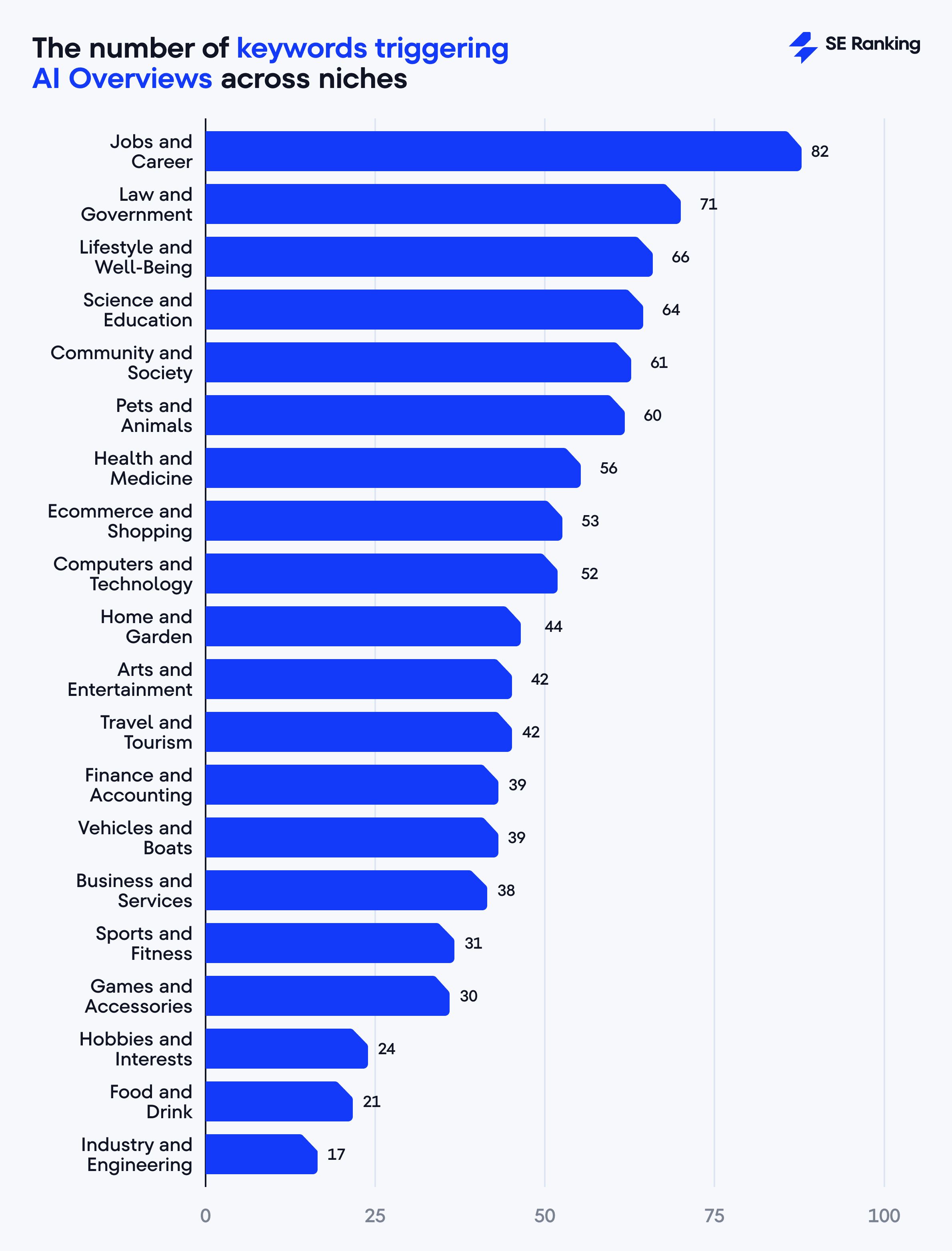

None of our newly created domains were cited as sources in the AI Overviews.
Niches that triggered the most AI Overviews cater to broad topics. This aligns well with the type of requests AI Overviews are designed to serve. Seeing the Law & Government niche among the leaders matched the observations from our previous studies where we saw AIOs triggered by a greater number of keywords from YMYL niches.
The fact that the Industry & Engineering niche resulted in fewer AI snippets suggests that Google is cautious with complex queries and topics. However, this may change with the introduction of the Gemini 2.0 model in AI Overviews, which may allow them to process complex, multimodal queries.
It often takes time and authority-building before domains are recognized as trusted sources worthy of inclusion in AIOs. That’s why we expected none of the domains to be used as sources in AI-generated snippets. However, having nearly half of the analyzed keywords leading to AIOs after publication is quite a high rate.
Conclusion
Our research shows how AI-written content performs in search and what results it can drive. We found that while established websites can give AI content a boost in rankings, even brand-new domains can win visibility and traffic. Of course, simply publishing AI content isn’t enough to compete for top SERP positions or drive significant organic traffic. Making improvements to content quality should lead to better results.
We’re continuing to test and explore, with plans to examine how internal links and images affect performance. We’ll also experiment with keyword clusters. In the meantime, you can run your tests by signing up for a free trial of SE Ranking. You’ll get access to tools and data that help you validate any SEO hypothesis, refine your approach, and develop a well-rounded strategy.


